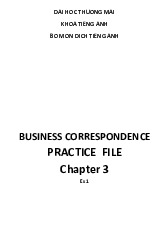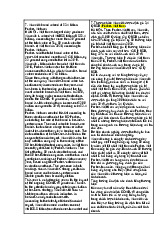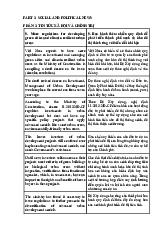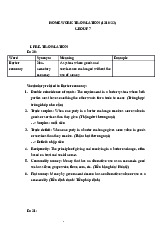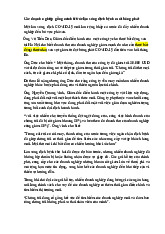



Preview text:
lOMoAR cPSD| 46342576
DEPARTMENT OF TRANSLATION AND INTERPRETING
ADVANCED TRANSLATION WEEK 4 – PRACTICE
Vietnam: strong exports carry weight of potential risks
With Vietnam being identified as a regional outperformer for exports, local businesses should remain alert to export
credit risk and take steps to protect their cash flows.
Vietnam is one of the fastest growing ASEAN economies. It has been identified by economists as one of the world’s
most promising markets for growth and investment, with GDP predictions for 2021 indicating growth of at least
7%. According to the Atradius report Promising Markets for 2021, Vietnam is one of a handful of countries
providing opportunities for investors and exporters. It is also one of just a small number of countries throughout
the world that successfully avoided recession during 2020 and is recognised as a regional outperformer for exports.
According to the United Nations COMTRADE database on international trade, almost half of Vietnam’s exports
are directed towards Asia (49%), with the greatest proportion of exports going to China, Japan and South Korea.
However, on a country-by-country basis by far the greatest percentage of Vietnam’s exports heads to the US. This
amounts to 28% of all of Vietnam’s exports, followed by China (including Hong Kong) at 21.8% and then Japan
and South Korea both receiving 7% of Vietnam’s exports.
With such a significant proportion of Vietnam’s trade exports heading to just two markets, Vietnam’s businesses
could benefit from paying close attention to the B2B payment behaviours in both countries. To survive and thrive
in a global market, Vietnam’s businesses need the security of solvent, reliable customers that pay on time,
underpinned by robust credit management policies and practices.
What are the payments behaviours of Vietnam’s primary markets: US and China?
Every year Atradius monitors payments behaviours in key sectors and markets throughout the world. The Payments
Practices Barometer Survey assesses key benchmarks such as the percentage of credit offered in a sector and
market, average payment terms, DSO (Days Sales Outstanding) and the percentage of sales that are written off.
The results of this year’s Atradius Payments Practices Barometer Survey for the US are concerning. Nearly half of
the businesses in Vietnam’s primary export destination reported deterioration in the payment practices of their
customers. 50% of B2B invoices were paid late and 8% were written off, far more than reported by their regional
peers. This is substantially fewer than the 50% of businesses that plan to absorb any bad debts internally (an inherently riskier approach).
In China the results of the corporate payment behaviour survey paint a very different picture. 4% of B2B invoices
were written off last year and 46% were paid late. Although the write-off rate in China was half the amount reported
in the US, it has increased by 33% compared to the survey we did in 2019, before the global pandemic hit. To
protect their own cash flow, businesses in Vietnam should monitor the ongoing creditworthiness of their individual
customers in addition to noting trends in each market’s payment practices.
A key reason behind such contrasting payment behaviours is the different experience of the Covid-19 pandemic
faced by businesses in each market. China has been relatively successful in containing the pandemic and as a result
has experienced less domestic business disruption. In addition, China has benefited from some pent-up export
demand caused by international supply chains disruptions.
Looking ahead, both of Vietnam’s major markets have expressed optimism. 60% of US businesses and 55% of
businesses in China anticipate the trading environment to improve over the next 12 months. Despite the optimism,
maintaining adequate cash flow and containing costs under the current difficult global economic situation are cited
as the top greatest challenges for these businesses. To navigate through this uncertain period, companies should
adopt a holistic and flexible credit management approach to mitigate risk associated with trades with domestic and overseas buyers.
How to minimise credit risk
When seeking to minimise credit risk, the golden rule for every business offering trade credit is know your
customer. If your customer is experiencing financial distress, they may take longer to pay your bill, or even default
on the payment entirely. Resources such as the Atradius Payments Practices Barometer Survey can be useful in lOMoAR cPSD| 46342576
providing a snapshot of a market and its local sectors. Although they will not be able to pinpoint the fiscal health
of your individual customer, they can act as a useful warning and provide you with insight into the local situation.
For example, this year’s US Survey shows that the steel/metals industry is facing many challenges with high
percentages of late payments and write-offs, and a third of businesses reporting a deterioration in their customers’
payment practices. As a result, businesses in Vietnam may benefit from taking additional steps to protect their
accounts receivable when trading with the US steel / metals industry.
Key steps for strong credit management
Active management of your credit accounts is critical to a successful credit management policy. This involves the
ongoing monitoring of your customers’ financial situation, as well as the financial health of your customers’ sectors
and markets. The global recession sparked by the Covid-19 pandemic, in particular, has led to widespread economic
stress and is a key reason why extra vigilance is required.
A trade credit insurance company such as Atradius that operates in international markets will have information on
sector performance trends and credit risk profile of more than 250 million businesses around the world. Such data
can be invaluable in helping you assess the creditworthiness of both prospects and customers and will help you
determine whether to offer trade credit and, if so, how much and what payment terms you wish to apply.
Making the most from international trade
The safest way to protect your accounts receivable from the risk of bad debts and late payments is to demand cash
up front for all of your sales. However, in a competitive international market, failure to support the liquidity of
your customers with trade credit and favourable payment terms may mean the difference between winning and
losing key contracts and may impact business growth.
With trade credit insurance your business can trade with confidence, with the knowledge that your invoices will be
paid even if your customer goes bust. What’s more, you can leverage the business intelligence and underwriter
knowledge of your credit insurance company to help you identify which businesses and markets represent the
greatest risks and where you might find opportunities for growth.
For businesses in Vietnam exploring the significant opportunities for growth presented by international trade, a
strategic approach to credit management grounded in high quality business intelligence could be the key difference
between business success and failure.
Back to blue: Let’s value our oceans again
Blue credits offer an innovative financing approach for attracting private capital to oceans health improvement projects.
In the midst of perhaps the worst crisis of our lifetime with loss of life, livelihoods and a spreading fear across the
world as a result of the Covid-19 pandemic, there have also been glimpses of the possibility to reverse decades of
environmental damage. This opportunity must be grasped to avoid the catastrophes likely to be unleashed if the
damage continues unabated. As the world works to recover from the ongoing crisis, governments need to include
in their recovery strategies, actions that can especially focus on sustaining and improving one of the most critical,
visible and universally needed environmental resources, our oceans – including all water bodies, seas, lakes and rivers.
The case for the oceans. The case, if ever needed, for protecting oceans is the sheer importance of this resource to
every sphere of life, including climate change. Oceans have been acting as a giant carbon sink, absorbing about a
third of the carbon dioxide (CO2) generated by human activities since the industrial revolution. However, while
helping mitigate climate change, with greater carbon absorption the oceans are also facing a 30% rise in seawater
acidity since the industrial revolution – an acidification rate estimated to be ten times faster than at any other period
during the preceding 55 million years. This is already impacting marine biodiversity, and with an estimated 1 billion
people dependent on seafood, and a global fishing market worth an annual US$100 billion, it will eventually affect the global economy. lOMoAR cPSD| 46342576
An 8-million-ton problem. The specter of polluted rivers across the region, several having already lost their battle
against a tide of municipal and industrial waste and deemed "dead", is worsened by 8 million tons of plastic ending
up in the oceans each year. And this is also coming back full circle with cities such as Bengaluru, Chennai, Cape
Town, Jakarta, Karachi, included in the lists of global cities facing water stress and water crises.
Projects are clear… funds are not. The projects that need to be done to address these challenges have always been
well known – municipal and industrial effluent treatment, agribusiness run offs, plastic waste management, coastal
protection, marine protected areas, river basin pollution control. The challenge has always been that of a shortage
of funds, conducive institutional and regulatory environments and financial incentives. This shortage of funds, an
estimated annual gap of US$459 billion, according to ADB, can only be met by a significant ramp-up in flows from
commercial and institutional finance, capital markets and public private partnerships.
However, such "blue" projects suffer from a lack of bankability, with many having either low tariff and revenue
levels due to affordability considerations or no revenue streams at all. Other risk factors include high cost
technology, environment clearances and land acquisition risks, further deterring the flow of private capital, and
resulting in a growing demand supply gap for capital. This is only likely to be exacerbated in the post Covid-19
scenario, causing further budgetary pressures on governments to fund such projects.
A time for "blue credits". How then can one persuade private capital into such projects? Several models exist within
blended or leveraged finance approaches, which aim to better apportion risk to the party – public or private – best
suited to manage that risk and hence create a more bankable project structure.
One mechanism that could be included to address the lack of revenues in many of these projects is that of "blue
credits", being developed by the ADB’s Southeast Asia department’s innovative finance hub. Based on the concept
of the "hybrid annuity" model that India tried successfully for its PPP road projects, this would essentially entail a
local or national government providing a pre-determined annual payment or "blue credits" to a project
implementing entity (whether a government-owned company, a PPP, or private sector entity), linked to performance
or impact indicators that a project needs to achieve, such as for instance, chemical oxygen demand (COD) and
biochemical oxygen demand (BOD) levels.
The main aim would be for private capital to finance most of the capital expenditure, take the construction risk and
subsequently focus on operational efficiencies, while insulated from revenue risks as long as project benefits are
delivered. The mechanism of blue credits should be seen as aligned with the principle of ‘avoided costs’ from
alleviating future economic or health disasters, such as diseases arising from lack of access to clean water, polluted
river bodies or decline in fishing stocks. An estimate of such avoided costs could provide a benchmark to limit the
level of blue credits provided to a project.
Similar to initially higher feed-in tariffs for wind and solar energy plants, the need for this financial support will
likely fade over time once scale and technologies improve, costs are reduced and “grid parity” is achieved. The
circular economy for waste and water treatment plants will improve when the sector develops, governments create
conducive regulatory environments and financial (tax) incentives, and counterproductive (fuel) subsidies are eliminated.
The payment mechanism for such blue credits could be ringfenced into dedicated special purpose vehicles funded
by governments, multi-lateral development banks and donors. ADB could work with interested governments in
developing the mechanisms and structures for such vehicles or ‘blue credit funds’ as well as in implementation of some early pilots.
A visible commitment. The elements of the idea above are not new, however creating a visible mechanism such as
this would clearly and strongly signal a government’s intent and commitment to both project sponsors and private
capital sources creating a clear momentum for leveraging in private capital of 3 or 4 times the government funds
committed. Including such mechanisms along with credible sovereign funds into post Covid-19 recovery packages
would be a critical step forward to renewing the attention on this hugely critical theme and lead to safer, healthier
and sustainable economic growth in the region. lOMoAR cPSD| 46342576
Một chuyến thăm, nhiều gợi mở
Chuyến thăm của Phó Tổng thống Kamala Harris cho thấy Việt Nam-Mỹ vượt qua khác biệt, gặp gỡ, đồng thuận
ở sự song trùng lợi ích trên nhiều lĩnh vực.
Lịch trình chuyến thăm dày các cuộc gặp cấp cao, các sự kiện và cả chuyện ngoài kế hoạch. Chương trình nghị sự
các cuộc gặp giữa lãnh đạo cấp cao hai bên đặt ra nhiều vấn đề, từ thương mại, đầu tư, quốc phòng, an ninh, khắc
phục hậu quả chiến tranh, y tế, phòng chống đại dịch, giáo dục, đến khoa học công nghệ…; cả trước mắt và lâu
dài; cả song phương và khu vực.
Gặp gỡ trực tiếp là dịp hai bên có thể trao đổi nhiều vấn đề quan tâm, làm rõ mong muốn của nhau, đưa ra cam kết,
thống nhất ý tưởng, chương trình hành động. Hai bên đã gặp nhau ở nhiều vấn đề.
Mỹ và Việt Nam đều coi nhau là một trong những đối tác quan trọng. Hai bên tìm thấy sự song trùng lợi ích trong
phát triển quan hệ song phương và đánh giá dư địa hợp tác Việt Nam và Mỹ còn rất rộng. Các nhà lãnh đạo cam
kết tiếp tục thúc đẩy mở rộng hợp tác trên nhiều lĩnh vực, trong chuỗi cung ứng toàn cầu…
Các tuyên bố, cam kết, sáng kiến, hành động luôn là những chỉ dấu cho kết quả của một chuyến thăm ngoại giao
chính thức. Rộng hơn, chúng thể hiện tầm mức quan hệ song phương. Như đánh giá của Phó Tổng thống Kamala
Harris, “chuyến thăm báo hiệu sự khởi đầu cho một chương mới trong quan hệ Việt-Mỹ”.
Truyền thông quốc tế đánh giá quan hệ Việt-Mỹ chứa đựng thông điệp cả tầm song phương và khu vực. Đó là vượt
qua khác biệt, gặp gỡ, đồng thuận ở sự song trùng lợi ích trên các lĩnh vực, cho hai bên và cho cả khu vực.
Điều cốt lõi là hai bên nhất trí tiếp tục tăng cường quan hệ Đối tác toàn diện ngày càng đi vào chiều sâu, hiệu quả,
vững chắc, cùng có lợi trên nguyên tắc tôn trọng độc lập, chủ quyền, toàn vẹn lãnh thổ, thể chế chính trị của nhau,
vì hòa bình, ổn định, hợp tác phát triển của khu vực và thế giới. Vậy là đầy đủ các tiêu chí cho sự phát triển bền
vững quan hệ song phương.
Do đó, phát triển nhanh chậm, đến đâu, tùy thuộc vào hành động tuân thủ nguyên tắc chính trị, tôn trọng lợi ích
quốc gia, dân tộc, thực chất hợp tác của hai bên và việc tiếp tục củng cố lòng tin chiến lược.
Người Việt Nam trọng thực chất, hành động thực tế. Ủng hộ tiếp tục thúc đẩy quan hệ song phương ngày càng phát
triển theo thỏa thuận giữa lãnh đạo hai nước.
Nhiều học giả, nhà ngoại giao trong và ngoài nước cho rằng quan hệ Việt-Mỹ đang thể hiện sự toàn diện, mang
tầm chiến lược và phát triển đúng hướng. Nhưng cũng có người “cảnh báo” Việt Nam bị lôi kéo hay bị sức ép nhiều
mặt từ nước lớn, “lợi bất cập hại”! Dù với động cơ gì, thì nghĩ vậy, nói vậy là chưa hiểu đầy đủ về Việt Nam.
Việt Nam cần sự ủng hộ của tất cả các nước. Nhưng độc lập, tự chủ là nguyên tắc sống còn. Việt Nam không dựa
vào bên ngoài để bảo vệ chủ quyền, “không đi với bên này chống lại bên kia”. Xưa đã vậy, nay càng vậy.
